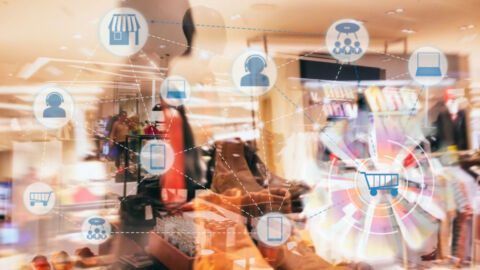As consumers migrate to smartphones, more retailers are rolling out new strategies that leverage customer engagement via mobile devices. One of these is check-in services, where the market opportunity is substantial.
A recent webinar titled, “Changing the Game in the Retail Store Through Your Own Branded Mobile Experience,” revealed that more retailers are investing in location-based marketing. The webinar discussed results from a Forrester Research survey which indicate that 114 million U.S. smartphone users employ check-in services. Forrester predicts that number will grow to 159 million by 2015. The webinar was sponsored by Digby, an Austin, Texas-based mobile platform solutions provider.
Check-In Services Evolve
Since its inception in 2008, check-in technologies have continued to evolve. Developed to entice users into sharing location information, they have shifted focus to include customized offers based on purchase history and are moving to loyalty rewards, according to Forrester Research Senior Analyst Peter Sheldon. Sheldon noted the four phases of this evolution:
- Phase 1 (2008 to 2009): All About Location. Check-in services such as foursquare used games and competition to induce users to login and share location information.
- Phase 2 (2009 to 2011): Rise of Basic Incentives. Seeking reward for their behavior, consumers excepted basic deals as the price for willingness to take action (e.g., scan a product bar code, make a purchase, etc.).
- Phase 3 (2011 to 2012):Emergence of “Smart” Deals. Consumers are starting to expect personalized, customized offers based on behavioral preferences and purchase history.
- Phase 4 (2013 on):Focus on Repeat Business and Customer Loyalty. Check-in services are inherently customer loyalty tools. By definition, they reward shoppers for repeatedly patronizing establishments.
Retailers Will Continue To Invest In Mobile Strategies
Forrester Research survey results indicated check-in users are “social” shoppers open to receiving social influence via Facebook or Twitter and more likely to research and purchase products online. Half (50%) of the check-in users surveyed said they only visited a store after receiving offers via their mobile device. Another 47% of check-in users purchased a new product or service in-store after reading friends’ status updates on social networking web sites such as Facebook and Twitter.
“Based on the demographics of the study, check-in users are an appealing segment to retailers; this group typically uses social networks such as Facebook, foursquare and Shopkick, and has a greater average annual income and higher education degrees,” noted Sheldon.
In 2012, technology and consumer adoption of smartphones has evolved, allowing retailers to embed location awareness into their own mobile strategies. “We’re at a point where retailers should start considering incorporating location technology and location awareness directly into their mobile strategies, and integrating this into their product for their own mobile commerce apps and web site.”
Although mobile commerce accounts for a small amount of overall online transactions, its usage is growing at a compounded annual growth rate of 39%, according to Sheldon. “Web site traffic and API hits from mobile applications are far greater for retailers with mobile strategies, who are averaging 30% to 40% of their overall web traffic coming from mobile devices. Consumers are already using their smartphones in-store for a variety of tasks, with the most obvious being to check store hours.”
Push Notifications Come To The Forefront
Push notifications are superseding SMS to provide contextual integration with a retailer’s mCommerce app. “Push notifications are tying mobile applications and mobile marketing in a contextual fashion,” Sheldon said. “Many retailers have had reservations about investing in push notifications, but as we move forward, it’s important for them to understand how this technology works and how they can leverage it. Many of the technical boundaries are disappearing quickly, with many solutions coming on the market to make it easier for retailers to adopt this technology.”
Sheldon revealed the four steps of deploying location-based and push notification technologies:
- Retailers define geo-fence regions around their physical stores;
- Region monitoring services alert retailers when a customer enters or exits a defined geo-fence;
- Contextual marketing rules determine what (if any) actions to take when a geo-fence boundary is crossed; and
- Push notifications are commonly used to send personalized offers or messages, often with a call to action that is integrated with the app.
Additional use of push notifications include driving impulse purchases for time-sensitive, nearby events; creating location-based brand engagement through customer loyalty; providing assistance on arrival in-store; and providing in-store or in-mall navigational support.
Digby launched Digby Localpoint, a new mobile platform that enables location-based marketing, analytics and commerce for brands. During the webinar, Digby VP of Products, Eric Newman, shared insights on how mobility impacts the in-store shopping experience through engagement and price transparency, and product scanning. “There’s a tremendous opportunity [in mobile] to engage with consumers in ways retailers have never done before,” said Newman.
The new mobile platform from Digby enables brands to create geo-fences around their stores and other points of interest, and embed those geo-fences into the brand’s app. The platform enables brands to achieve four strategic multi-channel goals: drive store traffic; engage with consumers in the store; enable mobile commerce; and provide web-style analytics to the physical retail store.
Click here to access the on-demand version of the complete webinar.












